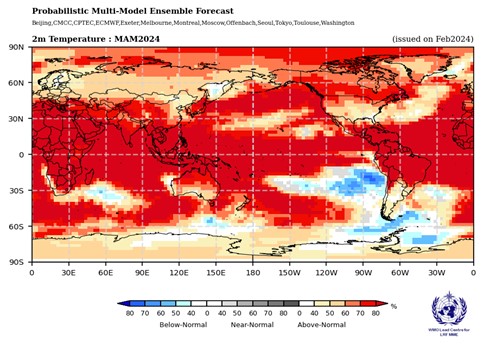In its seasonal outlook for March to May, India’s weather department, too, sounded alarm on the severity of heatwaves this summer. (PTI File)
The forecast comes days after IMD also warned of a higher number of heatwaves this summer, with more severity over peninsular states as well as Odisha and Maharashtra. According to WMO, Jan sea surface temperatures were highest on record
Similar to the India Meteorological Department’s (IMD) warning of a higher number of heatwaves over the country this summer, the World Meteorological Department (WMO) has also issued a global forecast for above-normal temperatures over almost all land areas between March and May. This comes at a time when the world has just witnessed the warmest year on record – 2023.
According to the global meteorologists, El Niño – the global climate phenomenon which influences the weather worldwide – is now gradually weakening, but it will continue to impact temperatures during the next few months. It is expected to fuel the heat already trapped by rising greenhouse gas emissions across countries. Scientists warn that El Niño typically has the greatest impact on the global climate in the second year of its development – in this instance 2024.
ALSO READ | Scorching Summer to Heat Up Poll Season Further, Higher Heatwave Days in April-May, Warns IMD
“Every month since June 2023 has set a new monthly temperature record and 2023 was by far the warmest year on record globally. El Niño has contributed to these record temperatures, but heat-trapping greenhouse gases are unequivocally the main culprit. The January 2024 sea-surface temperature was by far the highest on record for January. This is worrying,” says WMO Secretary-General Celeste Saulo.
PREPARED FOR HEATWAVES?
In its seasonal outlook for March to May, India’s weather department, too, sounded alarm on the severity of heatwaves this summer. The forecast was particularly concerning for northeast Peninsular India, many areas of Maharashtra and some areas of Odisha and adjoining areas, which may witness heatwaves as early as March.
“The seasonal outlook has clearly indicated which regions of India will have higher intensity of heatwaves, as well as higher maximum temperatures. It is critical that the local bodies step up their preparations early and chalk out a plan. The national elections are also expected to be held around the same time. The advisories become all the more important so that they reach the last mile and adequate precautions are taken,” said Abhiyant Tiwari, the lead climate resilience and health consultant at Natural Resources Defence Council (NRDC) India.
India braved an unprecedented summer season in 2022, with the warmest March on record, which also took a massive toll on agricultural production. The intensity of heatwaves was also high even during 2023, when they lasted for an unusually longer duration over the Indo-Gangetic Plains. According to experts, higher night and daytime temperatures, with no cooling and poor ventilation facilities, for a majority of population exacerbated the challenges.
WEAKENING EL NINO: GOOD NEWS FOR MONSOON?
The 2023-24 El Niño had peaked during November-January and began weakening thereafter. Although it was less severe than the 2015-16 event, it still ended up as one of the five strongest such events on record. According to the WMO, there is now about a 60% chance of El Niño persisting during March-May and neutral conditions around June. There is a chance of La Niña developing later in the year, but the odds are currently uncertain, it added.
ALSO READ | 2023 Was Hottest Year On Record, World Nears Critical 1.5 Degrees Celsius limit: Monitor
The waning of El Niño during June is good news for India, as the climate phenomenon is unfavourable for the southwest monsoon and is associated with droughts. The current prediction suggests it may not impact the crucial monsoon rain, but a more accurate assessment for India would be released by IMD in April and May.
El Niño, characterised by warming of the surface waters of the equatorial Pacific Ocean, naturally occurs on average every two to seven years, and typically lasts nine to 12 months. But it influences weather and storm patterns in different parts of the world. However, scientists are keenly studying it in view of the climate being changed by human activities.
